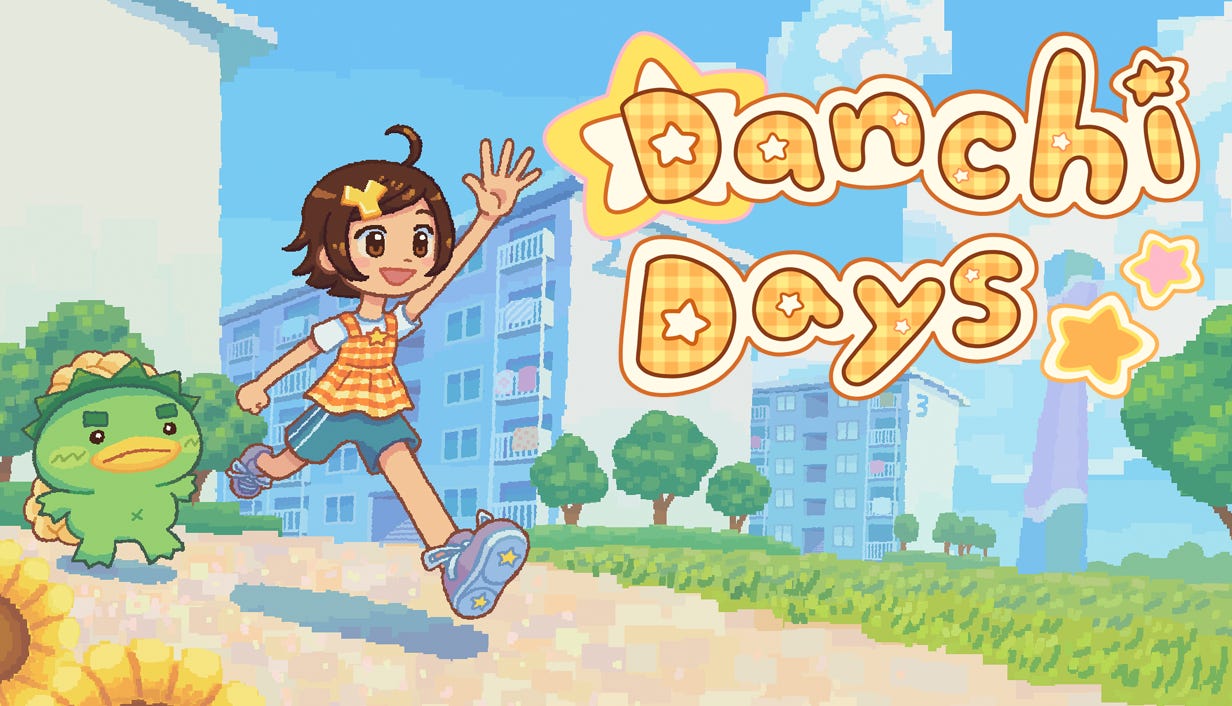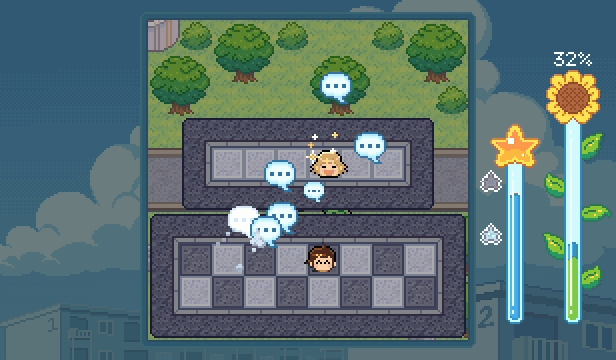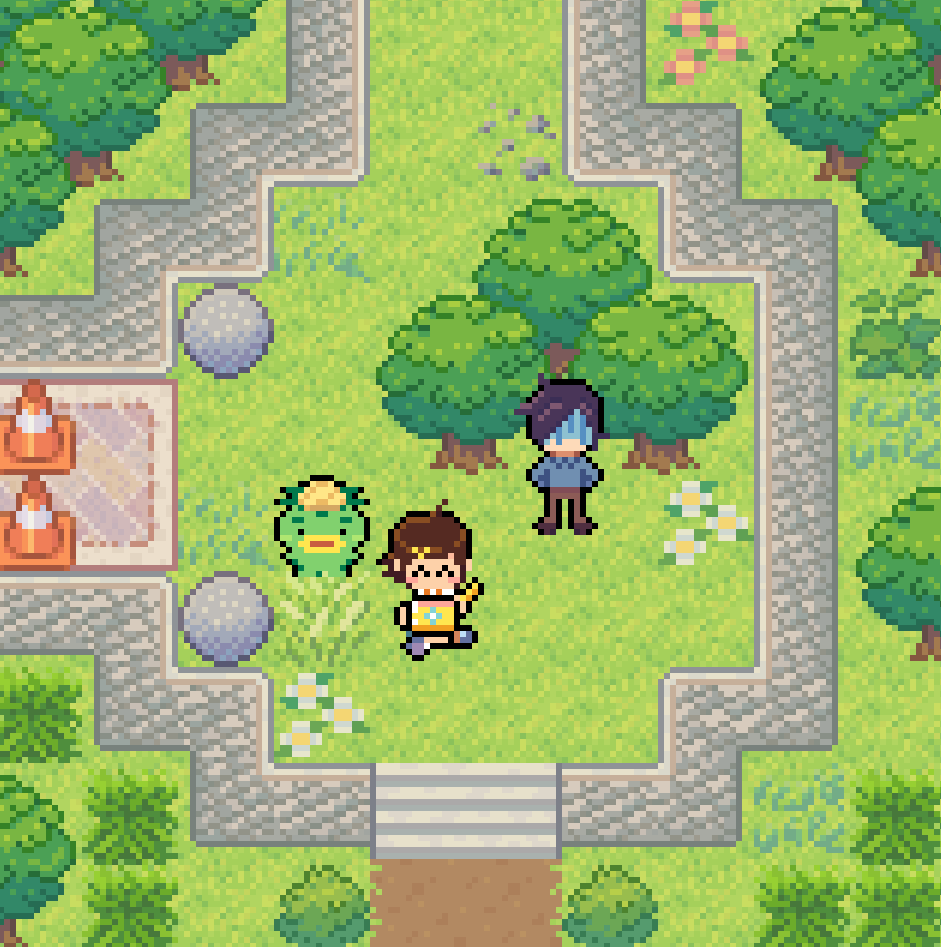Happy to announce the Danchi Days Demo is now available to play! Have fun and leave a review if you can, too! My detailed thoughts follow below.
https://store.steampowered.com/app/3312850/Danchi_Days_Demo/
This is a 60-90+ minute demo we put together over the past few months. It’ll also be available during Steam Next Fest and leading up to release. It’s a “Chapter 1”-style demo - you’ll be able to meet the main characters and experience the first parts of Danchi Days’ world… who will be your favorite neighbor to meet??
I hope you enjoy what we (sandy powder, mogumu, Melos Han-Tani) have brought together as the core development team of ‘gingham games’! Additionally, we’d like to thank flankoi for the Simplified Chinese localization, and Puchun Hsueh (JUN) for the Traditional Chinese (Taiwan) localization. Thanks to mushbuh, Olivia, Mei, Ryo Adidharma, Mooncat Games and Neon Noroshi for marketing assistance, and of course, our many playtesters who are credited in-game, and the content creators, streamers and writers who have supported us by streaming or covering our demos to this point! I’d also like to shoutout longtime collaborator Marina Kittaka for helpful conversations on the game’s design and art direction.
Melos’s Thoughts…
Ah, so you are very curious about Danchi Days? There’s a lot we can’t really capture in our marketing angles / store copy.
Loosely put, as purely a game, you could think of Danchi Days as a fusion of JRPGs, Visual Novel, Japanese-style Adventures, Action, and Puzzle games. It’s not strictly any of these - there are no battles, no fights, no hardcore puzzles - it’s sort of a thing of its own.
The game is also a fusion of our team's other interests. Of course, some of us live in actual Japanese danchis, so we’re able to do ‘field research’ every day simply by going outside (…or observing from the window.)
Just on the story side, with sandy powder's influences, there's the wide body of Japanese nonfiction essays, academic works, independent manga and comics, mainstream manga and anime, girl's anime, or the fields of education and pedagogy, etc. The game’s backbone - themes on aging society, dementia, senior care, work - which underlay all the characters and their quirky presentations - come from these interests and research. Many of the characters are sparked by ideas found in reading or life, which lends them all a genuine uniqueness and humor!
With the art, mogumu has a ton of experience as a professional illustrator, drawing on all sorts of influences, in particular, the art and characters of games like the unique cartoon style of Maple Story, the Harvest Moon series (especially the character spritework done in Mineral Town), Tomodachi Life and the playful emotions of Hamtaro games - all of which is felt most powerfully in her ability to come up with unique character designs via sandy powder’s specs and descriptions.
It’s thanks to our experience and interests that have made it possible to craft a bunch of memorable characters (and world).
Story Presentation & Internet
On the game side… Danchi Days has the character and dialogue presentation reminiscent of ensemble-cast-driven VNs, with a focus on the character portraits, emotion and sound, and a majority of text being delivered through dialogue. To balance that out, the internet’s writing is more essayistic, first-person, blog-ish. The RPG aspects come into play with how cutscenes are staged, and how characters develop and travel with each other (arguably this stems more from manga/anime/storytelling in general).
With the in-game internet, there's influence from the real-life early Japanese internet, revivals of personal sites (like Zonelets) but more importantly, the inclusion of the internet serves a vital design role of allowing players to access information nonlinearly and at their own pace - while also acting as an organic way of finding hints and deciding what to do.
Our reference was the game Uki-Uki Carnival’s internet and how they used their game’s internet to present their character and worldbuilding info.
Framing and Pacing
The framing structure of reviving a festival also takes notes from Uki-Uki Carnival, although loosely, this style of adventure is found in other Japanese games, where a simple framing goal is used to shape the more important thing (character interactions). E.g., collecting Love in MOON/Chulip, money in Giftpia, delivering bread in Doki-doki Poyacchio, making memories in Boku no Natsuyasumi, finding flowers or something in Sylvanian Family…
What's helpful with this is that the base task is so simple (invite as many characters as you can), and it contains an implicit marker of progress, but more importantly, that simplicity dovetails with a slice-of-life setting, leading you to meet dozens of unique characters and follow the story of Hoshino, her grandmother, her father, childhood friend Rio, and mysterious kappa festival assistant Moro-Q.
The tight pacing of the game is influenced from my work on past adventure games. Something interesting is always happening, or you have a lead on something to do. This is not really from a big to-do list dangling in front of you, or being bombarded with setpiece after setpiece. The pacing is achieved via intersecting and overlapping systems. In Danchi Days’ case, you're either progressing the main story, exploring the 2D world, talking to characters, browsing the internet, or playing a Sense Minigame.
Exploration and Sense Minigames
In a reading-heavy game like Danchi Days, it’s nice to balance that out with periods of not reading. So the game has you explore its setting of a Japanese danchi: parks, buildings, plazas, hills, forests. To aid in this, the screen aspect ratio is deliberately focused on individual rooms with low-res pixel art. This makes it easier to give each room a sense of place, while keeping the world navigable.
It’s important to me that in-game maps are designed from some sort of real life reference. When designing the maps for Danchi Days, I’ve taken a lot of inspiration from walking around many real-life danchis and Japanese neighborhoods, with their wide variety of verticality, hills, trees, weeds, and built aspects. I hope this approach to the map design can help convey the sense of the danchi and also make it easier to navigate the world.
But importantly, this sort of approach to map design lends a simplified way to read the environment for clues or interactions. And perhaps if you find the right interaction, you can start a Sense Minigame…
These Sense Minigames play an important role, in that they tactiley let you experience some of the things protagonist Hoshino is experiencing in-game. To do so I went with a puzzle-action approach, loosely inspired by some of my design work from the Anodyne series’ dungeons, Sephonie’s Linking Puzzles, and Angeline Era’s simple-to-learn bumpslash. Some helpful feedback and discussions with other designers helped me come to the realtime grid-based movement.
Basically, the point of this simple movement is that it’s a simple form of interaction that doesn’t need to be explained outside of initial tutorials and simple commands like “Bump trees and touch notes!”. I took some influence from Warioware here and how it’s very easy to figure out how to play each microgame, either instantly, or with a few rounds of failures.
What’s nice about taking this approach - over bespoke minigames with their own rules and controls - is that it lets players more quickly understand the kind of sensory/tactile ideas we’re going for. Tapping condensation of glasses to make large droplets, listening to sweeping brooms, etc. We can and do describe that through text and audiovisuals, but it’s also nice to give it the physical dimension.
Because you can only move or bump, the minigames don’t need much tutorializing (contrast Mario Party where you have to learn the rules each time!) “Moving and Bumping” are so abstract that it’s relatively easy to convert a narrative idea (“find a four leaf clover in a patch”, “listen to toilet pipes”) into a minigame. This helps the games organically fit into a mostly exploration/reading-focused game.
There’s another trick to the design, which is that one move = one energy, and each minigame has limited energy to use. This limitation lets the minigames have an inherent puzzleyness to them. While the games are balanced to be easy to clear, there are optional goals in the demo’s postgame where you’re rewarded for clearing games with fewer moves. This “simple to pick up, complex to master” is what drives the minigames to feel approachable to beginners, but not boring to the experienced. There’s intentionality to the design, so you have to engage with it in some way.
Each of these systems, from the dialogue to exploration to internet and minigames is - grammar-like in that they can be combined or tweaked in various directions while feeling organically like you're just in the "world of the game called Danchi Days"!
I hope you enjoy our demo (leave a review! Share it with a friend!) and please look forward to the release in 2026!!
- Melos Han-Tani (Composer/Co-Designer/Programmer/Story Feedback/JP to EN Localization)









